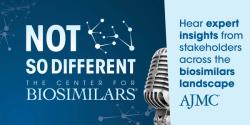© 2025 MJH Life Sciences™ and The Center for Biosimilars - Biosimilars, Health Economics & Insights. All rights reserved.
Biosimilar Market Development Requires Strategic Flexibility and Global Partnerships
Thriving in the evolving biosimilar market demands bold collaboration, early global partnerships, and a fresh approach to development strategies to overcome uncertainty and drive future success.
Adapting to market uncertainty, forging global partnerships, and rethinking traditional development strategies will be critical for future success in the biosimilar space, according to a panel of industry leaders at the Festival of Biologics USA conference in San Diego, California.1
Sharing insights from across the biosimilar pipeline, panelists included Michael Sarshad, managing director and biosimilar lead at Syneos Health Consulting; Haoheng (Sandy) Yen of Henlius USA; Sean McGowan, senior vice president of biosimilars and oncology at Amneal Pharmaceuticals; and Sujay Singh, CEO of Sujan Biologics.
Opening the discussion, McGowan highlighted key findings from a biosimilar market forecast report, noting the growing number of biologic products facing loss of exclusivity.2 However, he cautioned that a surprisingly low percentage of biosimilar molecules are currently under development, pointing to persistent high barriers to entry, stringent regulatory requirements, and difficult economic conditions that make the market less attractive.1
Sarshad added that, given significant market uncertainty, manufacturers must consistently reevaluate assumptions and engage in rigorous scenario planning. He stressed that successful biosimilar development demands seamless collaboration between clinical and commercial teams to ensure strategic, data-driven decision-making.
“Challenge the status quo…. Work with your strategic partners to rework things [for biosimilars].... Early adopters do tend to get rewarded,” Sarshad encouraged.
Navigating Regulatory and Market Dynamics
Yen discussed how regulatory reforms, including streamlined development pathways, have helped reduce costs and timelines but still present challenges, especially for complex molecules requiring extensive quality and comparability studies. Singh shared experiences from India, where intense local competition and unpredictable licensing environments complicate biosimilar commercialization. She emphasized the importance of forming global partnerships to mitigate these barriers and expand reach into new markets.
Both McGowan and Sarshad underscored the critical role of co-development, licensing, and strategic alliances in enhancing biosimilar market sustainability. Yen emphasized the integration of clinical and commercial planning early in development, while Singh and Sarshad pointed to globalization as essential, noting that achieving volume is critical to driving down costs and ensuring profitability.
The panelists agreed that the innovation pipeline must be balanced carefully with biosimilar development, as focusing solely on highly competitive molecules can limit return on investment.
Government Policy, Competition, and Market Viability
Discussion turned to the impact of government policies, particularly the Inflation Reduction Act, on biosimilar access and price competition. Sarshad warned that while increased competition can benefit payers and patients, an overly aggressive race to the bottom on pricing threatens manufacturer viability, calling for a sustainable market model that fosters both affordability and innovation.
Singh described how unpredictable pricing negotiations in India create challenges for long-term planning, reinforcing the need for clear, stable policy environments. Yen and Sarshad also flagged tariffs and international regulatory inconsistencies as complicating factors in global biosimilar strategy.
“We need to work on the regulatory piece, the legislation to share the risk more evenly among patients, providers, manufacturers, and payers,” McGowan stressed.
In closing, Sarshad urged biosimilar developers to rethink traditional strategies and remain flexible as market dynamics evolve. During audience Q&A, panelists addressed concerns around return on investment, with one audience member suggesting that companies focus on smaller, less competitive market segments. Panelists agreed, noting that targeted development strategies and strong partnerships could offer better opportunities for long-term success.
The discussion underscored a central takeaway for managed care stakeholders: sustaining growth in the biosimilar market will require a careful balance of competitive pricing, regulatory navigation, and strategic global collaboration.
References
1. McGowan S, Sarshad M, Singh S, Yen H. Biosimilar portfolio planning & pipeline development. Presented at: Festival of Biologics USA; April 23-24, 2025; San Diego, CA.
2. Jeremias S. The biosimilar void: 90% of biologics coming off patent will lack biosimilars. The Center for Biosimilars®. February 5, 2025. Accessed April 28, 2025. https://www.centerforbiosimilars.com/view/the-biosimilar-void-90-of-biologics-coming-off-patent-will-lack-biosimilars



